M2Tech HiFace DAC hands-on review
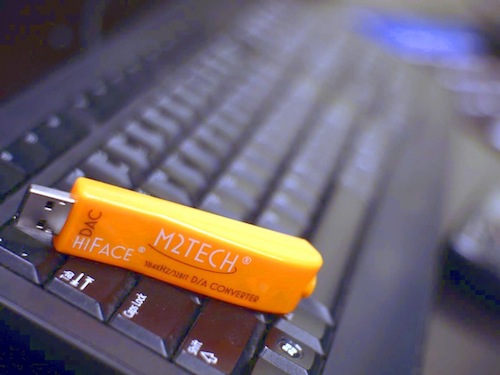
The M2Tech HiFace DAC is a little USB stick, is bright orange, sells for just €220, and yet is capable of handling the highest of hi-res music files you can buy. This I had to try…
The booming DAC market shows no sign of slowing: just as CD player users of two decades ago were being encouraged to add a black box to their machines to improve the sound, so the current move to computer-stored music has brought about a DAC revival.
After all, plug your computer into a DAC, and you can play music not only up to CD quality through your system, but – with the right software – in formats way beyond the limitations of the three-decades-old-and-even-then-it-was-outdated 16-bit/44.1Khz of the silver disc.
Not surprising, then, that, DACs everywhere now seem to have USB inputs for a computer, and neither is it a great shock to see the arrival of DAC-on-a-stick devices such as the Award-winning Audioquest DragonFly and Meridian Explorer, both of which combine the functions of DAC and headphone amplifier.
Italian company M2Tech has been making both high-end digital to analogue converters and USB-shaped digital devices for some time, but to date the USB products have been HiFace interfaces designed to convert USB into a high-quality S/PDIF output suitable for connection to a conventional DAC.
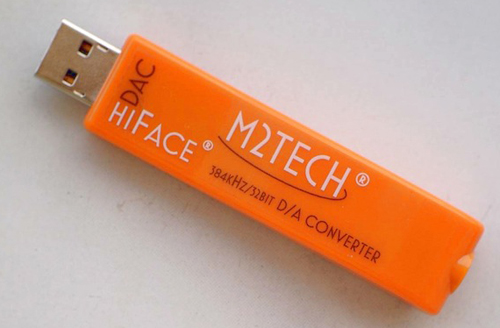
The M2Tech HiFace DAC is, as the name suggests, a USB DAC: fitted inside a bright orange shell, it sells for €220 – but this is no ordinary DAC.
Like the best out there, it uses asynchronous USB, in which the master clock for the digital data is provided by the DAC, not the computer's internal clock, so in effect the DAC tells the computer when it needs data, rather than trying to field everything the computer is hurling at it.
Get the What Hi-Fi? Newsletter
The latest hi-fi, home cinema and tech news, reviews, buying advice and deals, direct to your inbox.
OK, but then other similar devices do that, and just about every 'computer' DAC these days has an asynchronous USB port.
Hi-res, all the way to 32-bit/384kHz
What they don't do is handle resolutions all the way up to 32-bit/384kHz: in fact, very few DACs go all the way up there, that small number including some of the full-size models from M2Tech, and I don't know of any other USB-powered device with such capability.
So, what's that got to do with the price of fish? After all, isn't CD quality more than good enough for anyone, not to mention there being precious little higher-resolution music out there to play?
Well, the range of music available in 24-bit/96kHz, 24-bit/192kHz and greater resolutions is growing, and this little DAC – made and tested in Italy, by the way, with every unit subject to listening tests before packing and shipping – is all set to handle just about everything the current or future download music scene can throw at it.
By the way, what the HiFace DAC isn't really designed as is a headphone amplifier, though M2Tech says it may be possible to drive medium- and high-impedance headphones with it, adjusting the level with the computer's controls: really, this unit is designed to to be used into a conventional line input on an amplifier, connected using a cable from its 3.5mm stereo output to the amp's phono sockets.
The output is an entirely standard CD-player-like 2V, and the claimed frequency response is 5Hz-22kHz when using standard 44.1kHz content. Use 384kHz sampled stuff, and you get 5Hz-150kHz.
For some initial listening, I'm sitting here with the HiFace plugged into a MacBook Air via a short USB extension lead – for some reason I get really nervous about having devices like this plugged straight into the computer, just in case of physical accident – and a run of Audioquest cable from its line out to the line-ins on my Naim SuperNait amplifier, which is driving my usual PMC OB1 speakers.
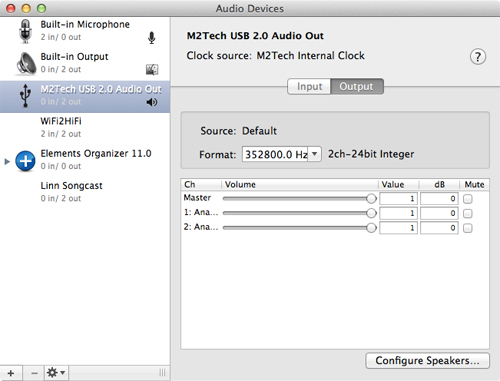
You'll need to load drivers for the DAC on Windows computers, but on Mac and Linux there's no need to install anything: all you have to do is select the M2Tech as the output device. In fact it can even be used with iOS and Android devices via a USB adapter.
I'm listening at home as I am also building and filling a new QNAP TS-221 NAS device – soon to be hands-onned here – and the music is coming from my existing TS-412, being added to an Amarra playlist on the MacBook Air and then being played out to the system.
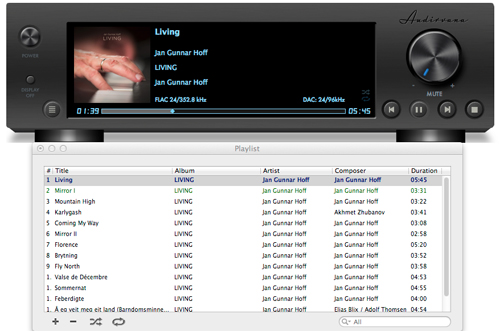
A word or two about playing this stuff: your standard iTunes just isn't going to be up the job. Living in Mac-world as I am at the moment, thanks to MacBooks being Haymarket standard issue (though the Air is my own), I've been using both Audirvarna (above) and Amarra software players to handle the music, almost of all of which is stored on my NAS in WAV or FLAC, and usually streamed out via the Naim NDS/555PS.
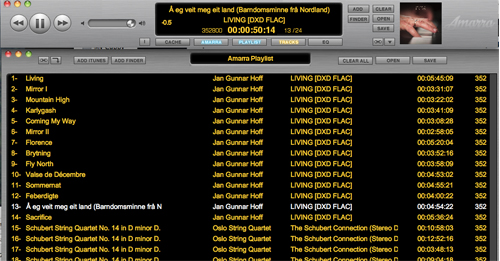
Both software packages are available in free trial versions, with Audirvarna handling content up to 24-bit/192kHz, and Amarra (above) going all the way to 24-bit/384kHz, and both interface simply with the HiFace DAC.
The day started well with Bob Marley in 24-bit/192kHz, took a turn for the more sombre mid-morning courtesy of the new 24-bit/48kHz B&W Society of Sound offering of Berlioz's Grande Messe des Morts – one of Sir Colin Davis's last recordings, with the LSO and choirs in the vast St Paul's Cathedral acoustic – and moved, via a spot of Daft Punk retrodisco in 24-bit/88.2kHz, to some ultra high-res classical music from Norwegian label 2L. In 24-bit/352.8Khz.
How does it sound? Well, to these ears, the answer is 'fabulous': the little orange stick delivers a sound with a presence, power and dynamic freedom I've only encountered with some very expensive digital hardware, and has the bass grunt and control needed to make any rhythm-section-driven music truly exciting.
Detail and definition are a given, and just get more striking the higher the resolution you choose to play, but the real revelation here is how well textures and characteristics of voices and instruments are conveyed, and how well that is achieved while retaining a delicious smoothness and sweetness in the treble.
M2Tech has built quite a reputation for engineering-led value-for-money products pushing the limits of digital sound without ridiculous price-tags, and on this brief audition I'd suggest the HiFace DAC could just turn out to be the company's most significant product to date.
And even better, in that embarrassing moment when someone says 'Is that a high-end digital-to-analogue converter in your pocket, or…?', at least now you'll have an answer.
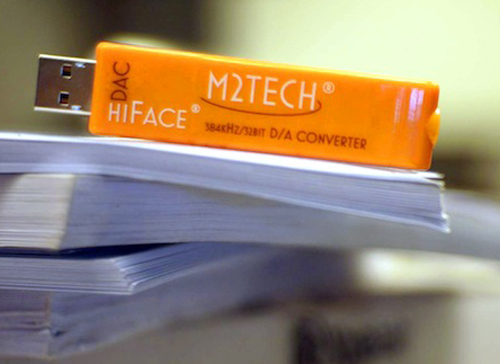
Written by Andrew Everard
Andrew has written about audio and video products for the past 20+ years, and been a consumer journalist for more than 30 years, starting his career on camera magazines. Andrew has contributed to titles including What Hi-Fi?, Gramophone, Jazzwise and Hi-Fi Critic, Hi-Fi News & Record Review and Hi-Fi Choice. I’ve also written for a number of non-specialist and overseas magazines.
